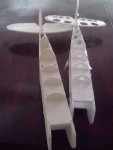Hai-Lee
Old and Bold RC PILOT
A while ago I tried a test build to see how I could save flying weight and increase strength of a FB design by using Balsa.
The resultant plane had a small weight saving mainly because I just "Slapped" Balsa sheets around all exterior surfaces, Wing excepted).which made the tail a little heavy. The wing whilst considerably lighter was done with the aim of actually reducing the weight. The whole plane was then covered in a covering film.
As the design was not a true FT design I started looking for something of FT design that I wanted to build, (something i did not already have that is). My eldest son has a severely damaged FT Spitfire and has been chasing me to repair or rebuild it so it is the FT Spitfire that I will build over the next month or so as an experiment to see how light I can build it and what percentage of weight savings I can achieve and still fly well with the full spectrum of maneuvers which were available in the original design.
I will actually be building 2 of the FT Spitfires so that I have a base line for comparison.
Episode one:
I cut out 2 fuselages from 5mm FB and the control was assembled and glued. It came in at 102 grams without the front and rear decks and without the Power pod.
With the other fuselage I stripped off all of the paper and it came out at 45 grams. I then made lightening holes in the fuselage, the deck formers, the underside rear and in the tail feathers. The all up weight was then 36.5 grams. From there the tail members were profiled to airfoil shape and now the weight is 35.5 grams.
Next episode I start to apply the Balsa and weigh the results.
The parts for the second fuselage with lightening holes.

the 2 fuselages side by side after the tail shaping

More to come in a few days!
The resultant plane had a small weight saving mainly because I just "Slapped" Balsa sheets around all exterior surfaces, Wing excepted).which made the tail a little heavy. The wing whilst considerably lighter was done with the aim of actually reducing the weight. The whole plane was then covered in a covering film.
As the design was not a true FT design I started looking for something of FT design that I wanted to build, (something i did not already have that is). My eldest son has a severely damaged FT Spitfire and has been chasing me to repair or rebuild it so it is the FT Spitfire that I will build over the next month or so as an experiment to see how light I can build it and what percentage of weight savings I can achieve and still fly well with the full spectrum of maneuvers which were available in the original design.
I will actually be building 2 of the FT Spitfires so that I have a base line for comparison.
Episode one:
I cut out 2 fuselages from 5mm FB and the control was assembled and glued. It came in at 102 grams without the front and rear decks and without the Power pod.
With the other fuselage I stripped off all of the paper and it came out at 45 grams. I then made lightening holes in the fuselage, the deck formers, the underside rear and in the tail feathers. The all up weight was then 36.5 grams. From there the tail members were profiled to airfoil shape and now the weight is 35.5 grams.
Next episode I start to apply the Balsa and weigh the results.
The parts for the second fuselage with lightening holes.

the 2 fuselages side by side after the tail shaping

More to come in a few days!












